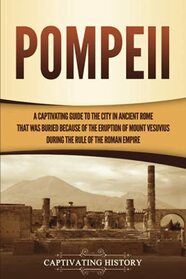One of the most delightful things about this book has to be the number of images sprinkled over the text. It makes the words more meaningful because the reader can see as well as read about various aspects of the story. In another of Captivating History's throw-away lines, they explain the difference between Hellenic and Hellenistic architectural styles. Hellenic style refers to ancient Greece before Alexander the Great's death in 323 BCE. Hellenistic styles include the influences (Egyptian, west and central Asia, and Greek culture) that affected the Roman world between Alexander's death and the rise of the Roman Empire.
Probably my favorite chapter was about the daily life of the people of Pompeii. It can be told because the people (and their goods) were literally frozen in place. This chapter describes their lives by the hour. Because there were no lights but the sun, their day started between 4 and 6 am. This book describes what they ate (both wealthy and poor) and what they did by the hour. An interesting fact was that the Romans, in their interactions with the Gauls, got a better soap and started bathing more.
I had a good chuckle about their "fast food." It was cheap, hot, fast food served with wine, for those unable to return home for meals. The wealthy had their meals served at home by their workers or slaves. Dormice were a delicacy of the wealthy! Yep, that's exactly what you think it is. Surprisingly, archaeologists did not find evidence of malnutrition in the people of Pompeii, even the slaves. On a more somber note, life expectancy was between 25 and 35-years. About half the babies born died before their fifth birthday.
The grand finale was the explanation of the 62 BCE earthquake and then the 79 BCE devastation. Because there was no quick communication, people did not understand what had happened until after the facts of the deaths. It is amazing to learn that no one searched the area until the mid 1700s CE. Wonderful reading and information.
Probably my favorite chapter was about the daily life of the people of Pompeii. It can be told because the people (and their goods) were literally frozen in place. This chapter describes their lives by the hour. Because there were no lights but the sun, their day started between 4 and 6 am. This book describes what they ate (both wealthy and poor) and what they did by the hour. An interesting fact was that the Romans, in their interactions with the Gauls, got a better soap and started bathing more.
I had a good chuckle about their "fast food." It was cheap, hot, fast food served with wine, for those unable to return home for meals. The wealthy had their meals served at home by their workers or slaves. Dormice were a delicacy of the wealthy! Yep, that's exactly what you think it is. Surprisingly, archaeologists did not find evidence of malnutrition in the people of Pompeii, even the slaves. On a more somber note, life expectancy was between 25 and 35-years. About half the babies born died before their fifth birthday.
The grand finale was the explanation of the 62 BCE earthquake and then the 79 BCE devastation. Because there was no quick communication, people did not understand what had happened until after the facts of the deaths. It is amazing to learn that no one searched the area until the mid 1700s CE. Wonderful reading and information.




